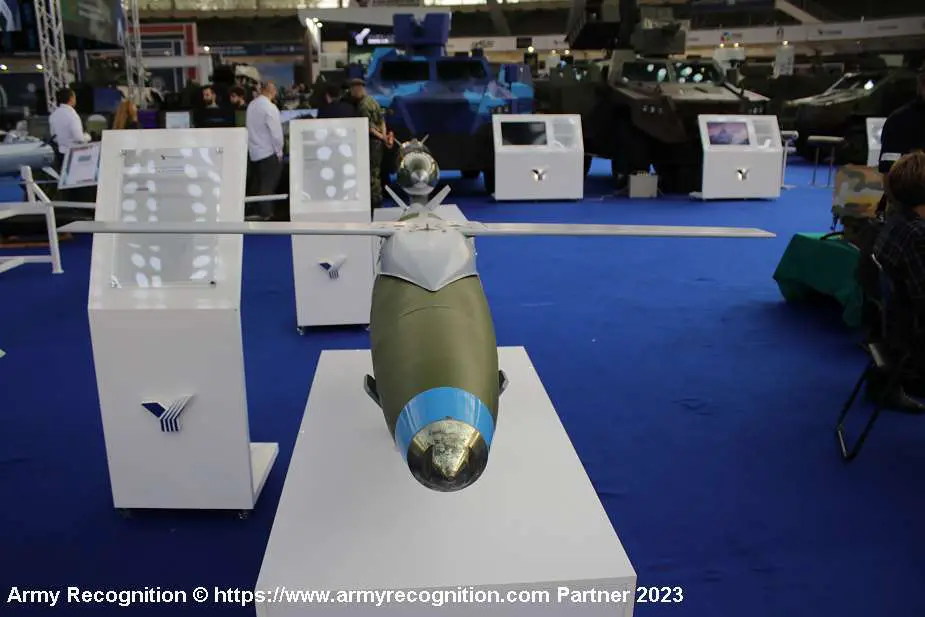Breaking news
Serbia proposes new Wing Assisted Guidance Kit for MK bomb series.
At the Partner 2023 exhibition in Serbia, Yugoimport showcases its latest innovation the Wing Assisted Guidance Kit for the MK bomb series. This autonomous system, which operates independently from the aircraft system, has been designed to significantly enhance the capabilities of standard unguided general-purpose bombs while minimizing the exposure of aircraft to the threats posed by enemy anti-aircraft defenses. With its own integrated guidance system, this kit has the ability to correct the trajectory of the bomb under a wide range of weather conditions, thereby enhancing precision and accuracy while reducing the circular probable error, regardless of the bomb's range.
Follow Army Recognition on Google News at this link

The Wing Assistance Guidance Kit for MK bomb series at the Partner 2023 exhibition in Serbia (Picture source: Army Recognition)
This advanced Wing Assisted Guidance Kit extends the range of an unguided bomb by over 80 kilometers, leveraging a proprietary algorithm developed at the Viatacom Institute. Furthermore, it incorporates a proprietary integrated navigation algorithm based on Global Navigation Satellite System (GNSS) and Inertial Navigation System (INS) technologies. This combination results in accuracy levels of less than 10 meters using GNSS + INS and less than 20 meters using INS alone. The operational environment for this system ranges from -40°C to +70°C, while it can be stored in environments spanning from -55°C to +70°C.
One of the advantages of wing-assisted guidance kits like the one presented by Yugoimport is their ability to extend the effective range of munitions. These kits often incorporate GPS and inertial navigation systems, allowing an aircraft to launch a bomb from a considerable distance. This capability enables military forces to target high-value objectives, such as anti-aircraft systems or command centers, without exposing their aircraft to the associated risks.
For instance, in a hypothetical scenario, an aircraft could launch a wing-assisted bomb from a distance of 100 kilometers, potentially neutralizing an enemy radar station without entering the radar's detection range. This long-range capability enhances strategic flexibility and reduces risks faced by military personnel.
Another feature of wing-assisted guidance kits is their adaptability to various weather conditions. Unlike systems that rely solely on laser or visual cues, these kits incorporate multi-mode guidance systems that remain effective even in adverse weather conditions, such as fog, rain, or heavy storms. This attribute ensures that military operations can proceed without interruption, regardless of the weather, thereby potentially increasing the overall effectiveness of campaigns.
For example, during a monsoon season when laser-guided systems might be less effective, a wing-assisted bomb could still accurately hit a moving enemy convoy, maintaining the momentum of the operation and minimizing disruptions.
One cost-effective aspect of these guidance kits is their modular design, which allows for easy installation on existing munitions. This feature means that military forces with stockpiles of conventional unguided bombs can retrofit them with wing-assisted guidance kits, potentially converting them into smart munitions. This approach not only saves time but also reduces the financial burden associated with disposing of old munitions or purchasing entirely new ones.
Perhaps one of the noteworthy aspects of wing-assisted guidance kits is their precision targeting capabilities. Advanced algorithms and sensors within the guidance kit ensure that the bomb can adjust its flight path in real time to hit a target with accuracy. This precision is particularly significant in urban warfare scenarios, where minimizing collateral damage and civilian casualties is a priority.
For example, in an urban environment, a wing-assisted bomb can be used to target a specific floor of a building where enemy combatants are located, potentially reducing the likelihood of unintended harm to civilians or property damage. This precision makes the use of such munitions potentially more viable in conflict zones.
Yugoimport's Wing Assisted Guidance Kit joins a growing list of similar systems from around the world. Notable examples include the American Joint Direct Attack Munition (JDAM), the Turkish Wing-Assisted Guidance Kit (KGK), the Russian KAB-500 series, the Israeli SPICE (Smart, Precise Impact, Cost-Effective) family, and the Chinese LS PGB.























